By
Team DIGO | 11/03/2016 | in
By Mark DiMassimo
Here’s how to get creative people to make you rich:

First off, don’t compromise.
Don’t give up one iota of ambition or one quantum of results orientation.
Don’t pretend to care about awards or fame or any of those other things that people think creative people care more about than money.
All you need to do is speak a language that lets creatives know that you are absolutely committed to BOTH – selling more and driving up brand value, money and relevant fame.
All you must do is never undermine their faith in your commitment to top-level achievement on BOTH of those scales, and then you win.
Sometimes this means saying “brand response” or “brand direct” instead of “direct response.” I know, it seems silly, but it’s a tell.
When you say “direct,” “direct marketing” or “direct response,” creatives hear, “Let’s just forget about who we are and what we want to stand for, and let’s just trick people into buying stuff.”
When you say “brand response” or “brand direct,” creatives hear, “I’m not sacrificing this brand for sales and I’m not sacrificing sales for this brand. Figure it out!”
Seems a small thing, but wait until you see how well it works! Because when you make it clear that you will settle for no less than success in the short run AND success in the long run, you become the client everyone in the shop wants to work for. You become the inspiring one.
When you show that you don’t buy the false choice between selling and brand building, you’ll see it in the eyes of the creative people you inspire. Because while, yes, a lot of creative people like awards and recognition, that’s not what they live for. What creative people live for is solving the most difficult problems brilliantly.
For more on how to get creative people to make you rich, consider using The 10 Signs of an Inspiring Action Brand as your roadmap.
By
Team DIGO | 10/28/2016 | in
Behind each company we work with, there is at least one inspiring action marketer. Who works with us day in and day out. Who’s on every conference call and in every meeting. Who collaborates with us to align on strategy, creative, and so much more. Whose passion and enthusiasm for ideas inspires us to strive for greatness.
Brands are the present evidence of past marketing visionaries. We don’t buy past performance. We invest in the future, and the future is in the hands of the inspiring action marketer of today. And we invest beyond all calculation in people who inspire us.
That’s why at DiMassimo Goldstein, our clients aren’t companies, they’re marketers. They’re a part of the team. And while the end goal is always business growth, we know that in order to achieve that, we must grow as marketers – and help marketers grow — in the process.
Last week, we got to see fruits of this growth first hand when two of our clients, Jodi Fronczke of TradeStation and Liz Robinson of Sallie Mae, were among those honored as The Gramercy Institute’s “20 Rising Stars in Financial Marketing.”
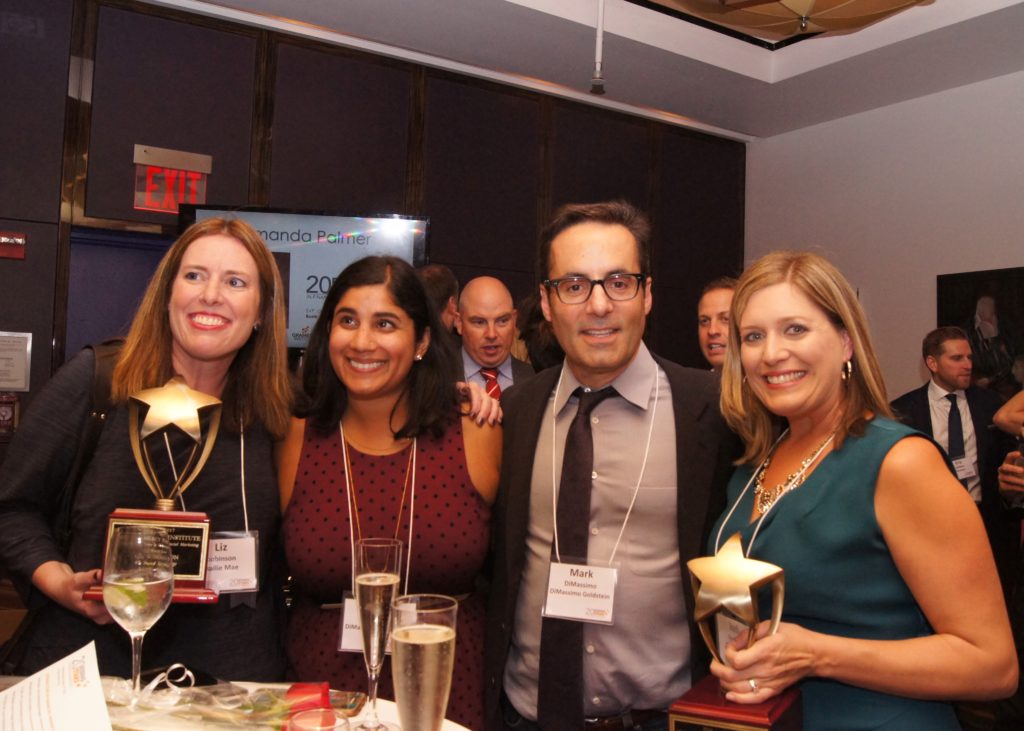
From left to right: Liz Robinson (Rising Star), Nehal Beltangady, Mark DiMassimo, Jodi Fronczke (Rising Star)
Both Jodi and Liz are smart, hard-working and visionary marketers who deserve every bit of this recognition. They handle every marketing problem that comes their way with absolute grace, rising to the challenge each time. They truly value their partners, and inspire their teams. We couldn’t be more proud of them.
For twenty years, we’ve always put the client first, and when you commit to your client’s success, great things are going to happen. We love working with stars, and now we have an entire constellation. We won’t stop until our stars are lighting up a galaxy!
Congratulations on the honor, Jodi and Liz! And more importantly, thank you for inspiring us every day.
By
Team DIGO | 10/26/2016 | in
We wrote this over a decade ago, and ever since we’ve been discovering and inventing new ways to organize and inspire word-of-mouth in social networks and beyond. Enjoy!
We’ve all heard the expression, “Word of mouth is the best advertising.” We’ve seen brands built seemingly on strong word-of-mouth alone. But what’s harder to see is the contribution of strong word-of-mouth to brands with significant traditional advertising budgets.
Two hundred million dollar advertisers with negative word-of-mouth are not uncommon, and without fail the word-of-mouth negates the advertising. On the other hand, strong word-of-mouth will multiply a budget, making $15 million work like $150 million. Just consider Starbucks, Crunch Fitness, and JetBlue Airways.
How can you manage word-of-mouth? Start with your heaviest, most loyal users and turn them into Brand Advocates. These are people so passionate about the brand they can’t help but express themselves in your support. Know them. Know what they’re saying. Use planning to learn their word-of-mouth strategies for advocating the brand. Then devise programs to support those strategies.
By
Team DIGO | 10/21/2016 | in
By: James Nieman
“The Macintosh-style of travel”
Those are the words of Josh Udashkin, the CEO and founder of luggage company Raden, and although it may feel weird to group luggage and Apple in the same sentence, that’s exactly what he wants you to do.
So, when it came to designing his own product, Udashkin picked Kenneth Sweets, the principal designer behind the Apple-owned Beats Electronics (formerly Beats by Dre) as the man for the job. The result of that collaboration was a beautifully designed suitcase that’s boldly minimalistic. Unlike most of the antiquated luggage industry, it doesn’t feature any unnecessary zippers or awkward and clunky compartments. Instead, it’s fearlessly simple. It’s iconic.
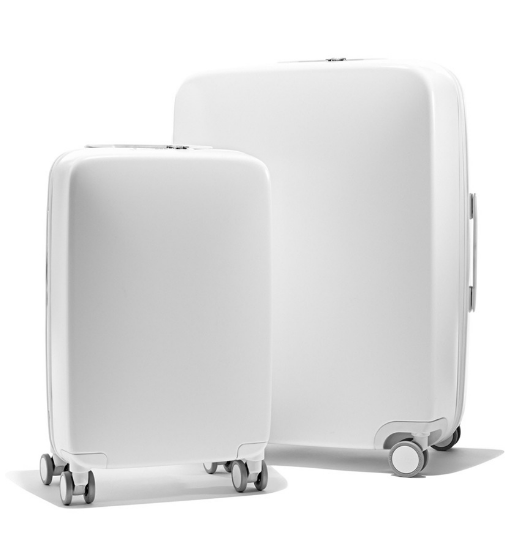
But Apple is not Udashkin’s only inspiration, and if you take a closer look at the other brands that he has modeled Raden off of—Dollar Shave Club, Casper, FitBit, Everlane, and Dyson—a common theme begins to emerge.
Experience Design.
After living out of a suitcase himself, Udashkin noticed that the luggage industry was one of the few remaining categories where industrial design and technology had not yet been married, and thus the inspiring idea of Raden was born. A “smart” bag that could pair technology with design to offer a delightful consumer experience for the plugged-in passenger.
Like Warby Parker and TOM’s, Raden subscribes to the direct-to-consumer business model, using technology to cut out the middleman. This has allowed them to sell premium suitcases at an affordable price. Everything from the wheels to the case screams luxury—yet the Raden suitcases range from $295 to $395.
And like many of the aforementioned brands, Raden thinks “Big Brand.” They know that every single brand touchpoint is an opportunity to create a positive interaction with the consumer and therefore design each of those touchpoints in ways that enhance the overall user experience.
For example, Raden suitcases arrive at your doorstep in a bag that also acts as a laundry bag, offering their passionate consumer base with the option of separating their dirty and clean clothes while traveling. Inside the suitcase, you’ll find a sleeping mask and headphones.
It’s these type of small iconic actions that really help to dramatize their brand. It’s what takes normal consumers and turns them into brand devotees. It’s what propels companies like Dollar Shave Club to billion-dollar evaluations. And it’s what makes Raden our Inspiring Action Brand of the Week.
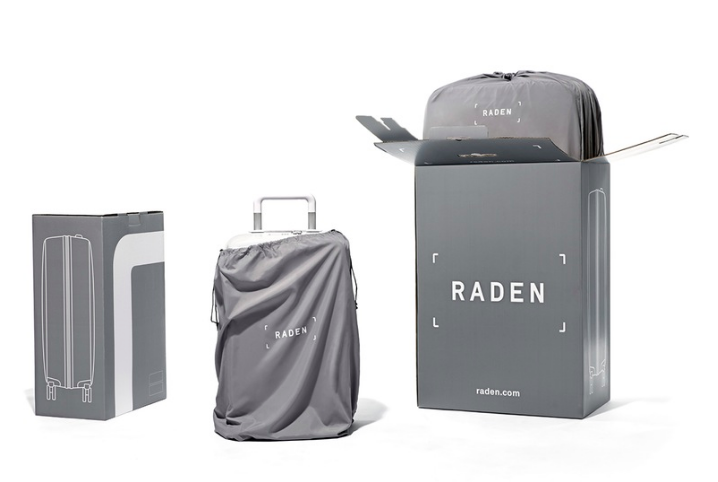
But the package design is just the beginning. Both products—the A22 Carry and the A28 Check—feature built-in chargers, solving the pain of having to survey a packed gate for an outlet to become available or, worse, having a dead phone and/or tablet on a long flight. With the Raden, you can charge your devices anywhere.
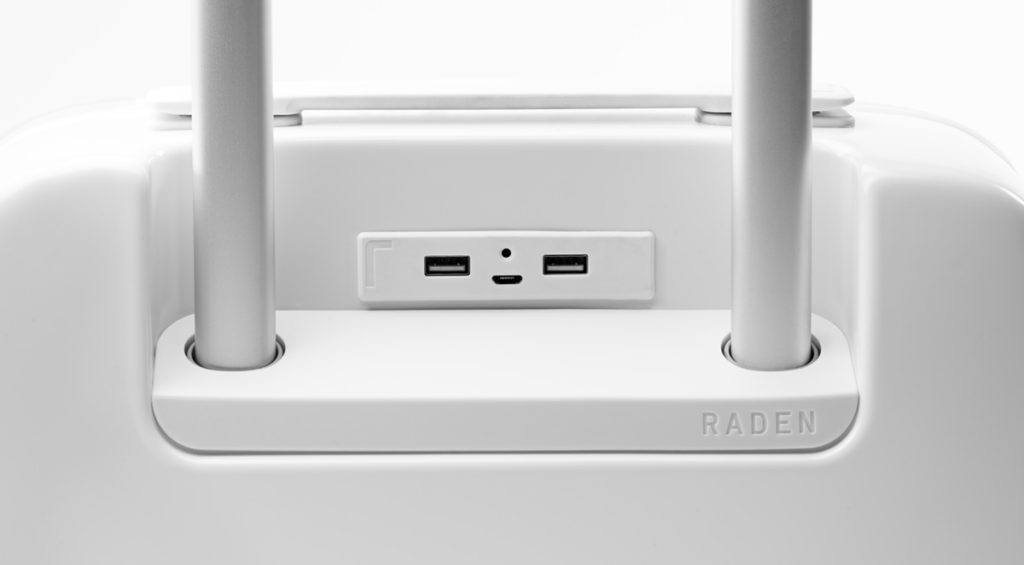
The handle at the top of the suitcase doubles as a weight sensor so that customers can travel worry-free of last-minute overage fees, which, if you’ve never been forced to incur, tend to be ridiculous.
To activate the integrated scale, you’ll have to download their app.
App? Yes. Raden’s mobile aspect is where it truly solidifies itself as the leader in travel tech.
The app, which is free, contains a plethora of features that are designed to rid the consumer of any traveling woes. There’s a location awareness feature so that you know exactly where your bag is at all times. Now, instead of waiting around at the baggage claim for 15 minutes, you can go and grab a coffee and relax until you’re notified that your Raden is arriving.
The app also lets you know the weather and status of your flight, the closest route to the airport, and the length of the security line. And, like everything else Raden, it’s designed with the consumer in mind. Easy to navigate and crafted for a delightful user experience.
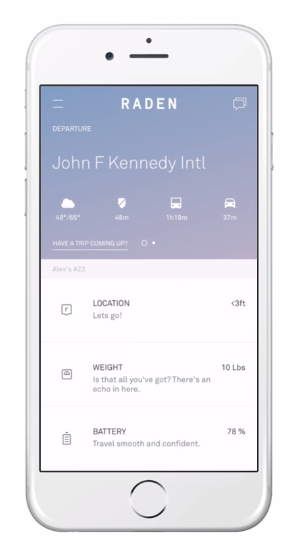
Instant Success
In its first four months, Raden sold $2 million worth of suitcases—and it hasn’t showed any signs of slowing down.
Speaking of the lucrative opportunity the $40 billion luggage industry presented, Udashkin said, “Younger people don’t have an affinity to a particular luggage brand.”
If Raden continues to follow the 10 Signs of an Inspiring Action Company and keep the user experience front and center, that’s going to change. And change fast.
By
Team DIGO | 10/11/2016 | in
If you want to run a first class marketing organization, benchmark against the category leader. Right?
Wrong.
Look at your category and you’re likely to see this common landscape: A market-share leader whose marketing is effective and probably conservative; a host of other players who more or less imitate the marketing tactics of the market leader; and then, maybe, one “challenger” who is the “idea leader” in the category.
Time and the market have proven that these idea leaders frequently become share leaders. Look at Charles Schwab in the brokerage category. Or Southwest and JetBlue among airlines.
The “idea leader” road is not for the faint of heart, but it’s more likely to succeed than shadow marketing the share leader. Besides, it’s a lot more fun.
By
Team DIGO | 10/07/2016 | in

I’ve noticed that people are surprised when some companies dramatically outperform other companies…
when they grow both revenue and brand value…
when they disrupt and then dominate their categories…
and when they sell or go public at phenomenal valuations…
But I’m not surprised.
I’ve studied those companies intensely for years. I’ve learned directly from the top decision makers exactly what they do differently. I’ve made them the focus of my career. And here I will share with you the single most important thing they do…
They define the word “brand” differently.
The great change agents, disruptors, and CMOs who can write their own tickets all have this in common. “Brand” means something very different to Dollar Shave Club, Airbnb, Warby Parker, and Casper than it does to most marketers.
Most marketers – and in fact, most business leaders – still associate “brand” with logos, style guides, naming conventions and brand ads. This is what I call small brand.
Not the big winners. They subscribe to the concept of BIG BRAND.
They understand that the brand, is first and foremost, an experience in the mind of the user. They understand that to manage that brand is their ultimate job; that it is in fact the main purpose of the organization. They understand that to manage that inner experience, they must design and direct all of the external evidence of the brand that the user experiences.
Therefore, these companies think of “brand” as the entire user experience, not just of the product and promotion, but of every touchpoint related to the brand. That’s Big Brand.
Then, in order to organize and change everything about the way the brand is experienced, they think about the brand this way:
• They think about the brand spirit. They get clear about what the spirit of the brand will be. That spirit will transform every touchpoint into a brand experience. For Tesla, it’s visionary, bold and futuristic. For Airbnb, it’s adventurous, social and natively comfortable. For Dollar Shave Club, it’s fun and frank and super-practical.
• They think about the brand meaning. They know that an inspiring idea can organize and change everything for the brand. They know that people want to buy into more than a value proposition; that they want to be part of something meaningful. For Casper, it’s a more rested culture. For Betterment, it’s a world of tech-savvy, smarter investors. For Tesla, it’s a world without smokestacks and rising oceans. For Dollar Shave Club, it’s a club of guys who look great and still have some money in their pockets.
• They think it applies to ALL their communications. Unlike small brand thinkers who often unthinkingly expose more people more often to brand-damaging promotional come-ons that sap the value of the brand, Big Brand thinkers view everything they do as part of the user experience, part of the brand. They generate more sales, more efficiently, by thinking brand response rather than direct response. In brand response, the brand insight makes customer acquisition more efficient while it builds brand value. The better it works, the more the company can afford to do. The more the company can afford to do, the more it sells and the more valuable its brand is. It’s a virtuous cycle. The opposite of the one that kills the small brand goose.
• They design phenomenal fulfillment experiences. Brand experience design is a mindset that pays huge returns. And it doesn’t have to cost a lot of money! It’s shocking to us that so many companies just deliver in a normal envelope or a cardboard box. It’s crazy that they don’t see their trucks, boxes, crates, envelopes, cards, keys, bags, packaging and even invoices as inspiring brand experiences ready to happen. We are appalled at the enormous waste of owned and tightly targeted media that is underutilized. Casper puts a whole mattress in a box – a story with every delivery! Dollar Shave Club includes Bathroom Notes with every well-designed delivery, mastering their brand domain. Our boxes for Gateway had spots, and you could see them from two blocks away. Our FreshDirect trucks became popular rolling billboards and backdrops for a million selfies. From our logo to every element of delivery packaging, we worked with our brilliant friends at HelloFresh to make every surface and gesture speak the brand. This year, we evolved Weight Watchers’ Starter Kit from a concept to an actual kit, and both recruitments and member results improved dramatically!
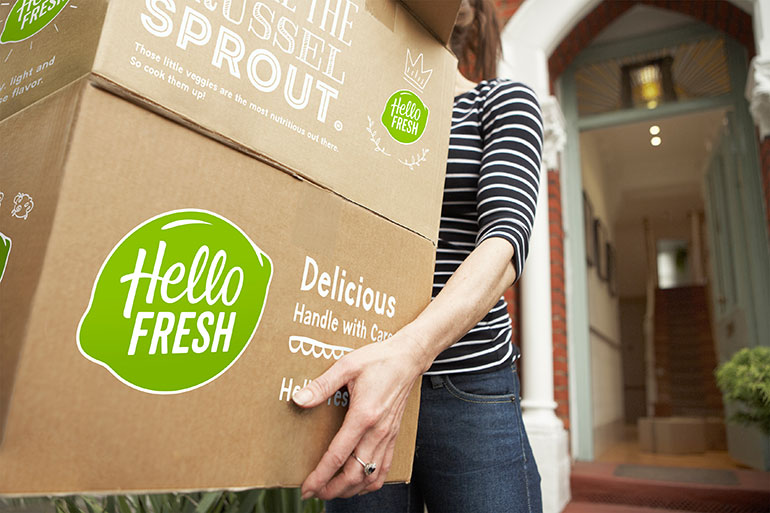

• They think about how media creates powerful brand associations. So, in addition to effectively increasing their media budget by 15% or more by insisting on transparent, accountable media, they also use a balanced scorecard for optimizations. This makes both acquisition efficiency and brand association central. It also includes location and purpose to, again, better align to the experience of the user.
• They think about being and doing the brand, not just marketing and promoting it. Because they know that today, everyone is connected to the true word-of-mouth about products and brands, they know that what they do and what they are means more than what they say they do and are.
And yes, they view the people who interact with their marketing as users and friends, rather than “targets” or even “audiences.” They know that today, people are trying to use our marketing and our brand to make meaningful and lasting changes in their own lives. Big Brand thinkers know that’s what we’re here for.
If this concept of Big Brand intrigues you, you may want to check out this roadmap. It’s the same one we use for smaller companies with smaller budgets to build dominant, category-disrupting big brands. It’s the same roadmap we use to help big companies to turn the ship around and succeed in our mobile-and-social-acquisition-driven marketplace.
I’d love to talk to you about Big Brand, Brand Response and Inspiring Action companies. Please don’t hesitate to reach out to @MarkDiMassimo or mark@digobrands.com.
By
Team DIGO | 09/29/2016 | in
For decades, Ty Shay has been the change agent that CEO’s dream of.
I was first introduced to Ty while he was the CMO of Hotwire.com.
“You had written a piece…it was about how the goal of the agency should be driving performance while at the same time driving a brand…It seemed like we were kindred spirits, which is why we made the change.” – Ty Shay
And kindred spirits we were. In just three quick years we were able to grow Hotwire.com from a Silicon Valley start-up to a top-five travel website, which is where it was when it sold for $663 million.
Since then, Ty has used the same brand response principles I wrote about in that piece to write his own ticket to any CMO job he wants.
So how can you be like Ty? How can you get any CMO job you want? Listen to the full interview below to find out:
If you’re interested in continuing the brand response conversation, email me at Mark@digobrands.com
By
Team DIGO | 09/27/2016 | in
Clichés. Hoary old ideas that won’t die. Every category has them, along with marketers to whom they are sweet music and the be-all-end-all of “what works.” But what happens when all the old ideas stop working? Or when your formerly great idea has been so widely copied that it’s not your idea anymore? Or what if you are just one of those daring marketers who aims for something more than cliché results? How do you get people to go along?
Try a Ritual Burning of the Clichés. Call your team together, including your agency partner or partners. Ask everyone to bring their best examples of category creative. Together, brainstorm an extensive list of clichés. From “free toaster” to “skinny model,” every category has them. Once you have a list, your team may find it very satisfying to actually burn something. It could be the whole pile of clichés or just the worst of the bunch. Keep a fire extinguisher handy. Think of it as lighting a fire under the organization.










